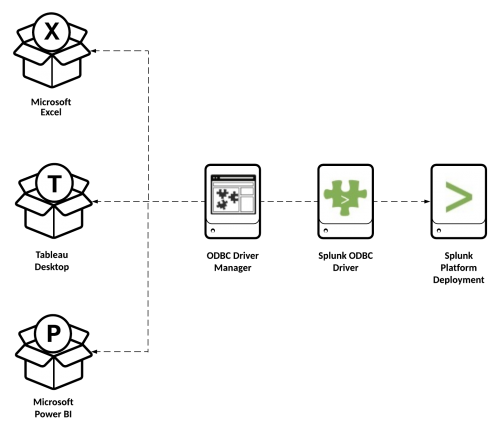The Splunk ODBC Driver
The Splunk Open Database Connectivity (ODBC) Driver allows a Splunk platform user to connect Microsoft Excel, Tableau Desktop, and Microsoft Power BI (Microsoft Windows machines only) to their Splunk platform deployment through Open Database Connectivity. After installing and configuring the Splunk ODBC driver, you can visualize and report Splunk software data directly from Microsoft Excel, Tableau, or Microsoft Power BI.
How the Splunk ODBC Driver fits into your Splunk platform environment
Open Database Connectivity (ODBC) is a mechanism that enables ODBC-compliant apps to access data sources such as database management systems and, using the Splunk ODBC Driver, a Splunk platform server. The Splunk ODBC driver is installed on a machine in your environment, and not in your Splunk platform deployment
The following diagram illustrates how Microsoft Excel, Tableau Desktop, or Microsoft Power BI accesses your Splunk platform through the Splunk ODBC Driver. Within Excel, Tableau, or Power BI, you configure the ODBC Driver Manager, which uses the Splunk ODBC Driver to access your Splunk deployment server.
The Splunk ODBC Driver can be used to connect and access data from Splunk Enterprise or Splunk Enterprise Cloud instances. The cloud instance must have the management port 8089 open to enable REST API access for the driver to work. For assistance with such requests, contact Splunk Support.
The main advantage of using the Splunk ODBC Driver to connect an app to your Splunk platform is the ability to use a familiar interface, such as Microsoft Excel, Tableau Desktop, or Microsoft Power BI, to perform actions that you might not be as comfortable doing with Splunk. For example, you don't have to use the Search Processing Language (SPL) to interact with a Splunk deployment server. You can instead use the Query Wizard in Excel or the interface in Tableau. The Splunk ODBC Driver then translates your actions in the app to SPL behind the scenes.
Get support and find out more information about the Splunk platform
Support for the Splunk ODBC Driver is provided by Splunk support.
If you have a support contract, file a case using the Splunk Support Portal. See Support and Services
You can also find help through the broader community:
- Ask questions and get answers through community support at Splunk Answers
- Splunkdev Google Group
You have a variety of options for finding more information about Splunk:
- Review the Splunk platform documentation
- Find answers through community support at Splunk Community
- Get support through the #splunk IRC channel on EFNET
| Hardware and software requirements for the Splunk ODBC Driver |
This documentation applies to the following versions of Splunk® ODBC Driver: 3.1.0, 3.1.1

 Download manual
Download manual
Feedback submitted, thanks!